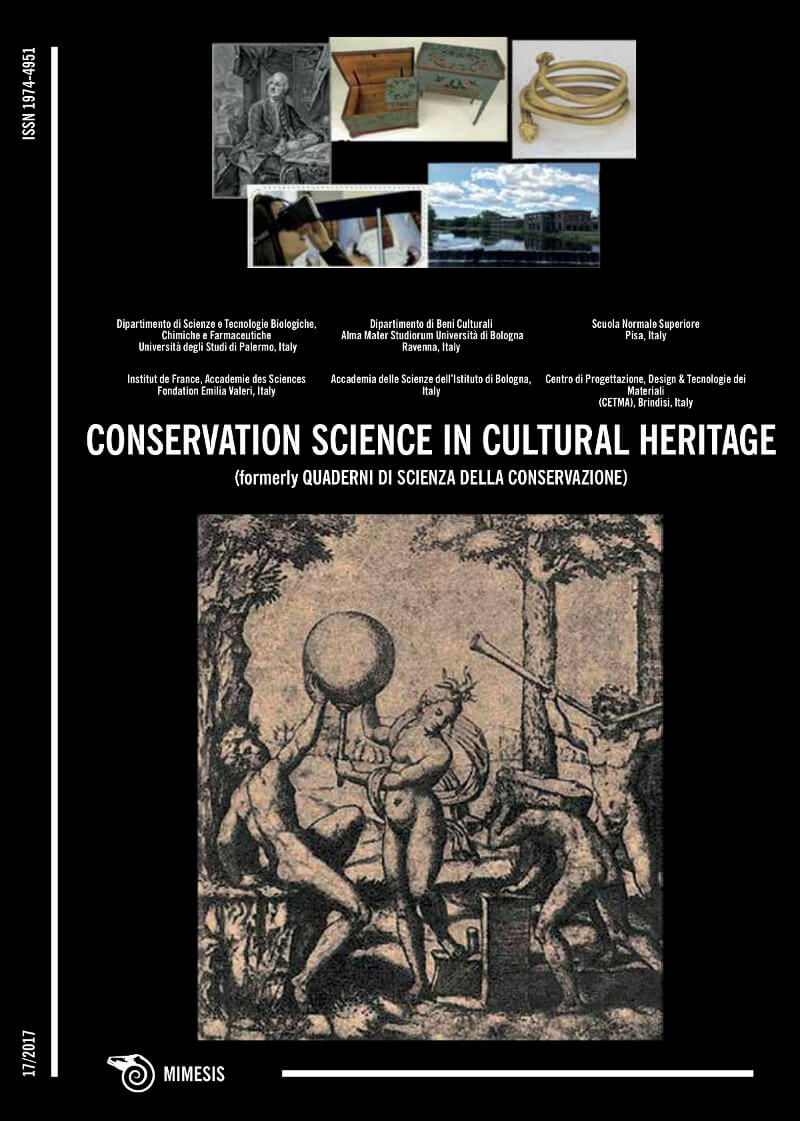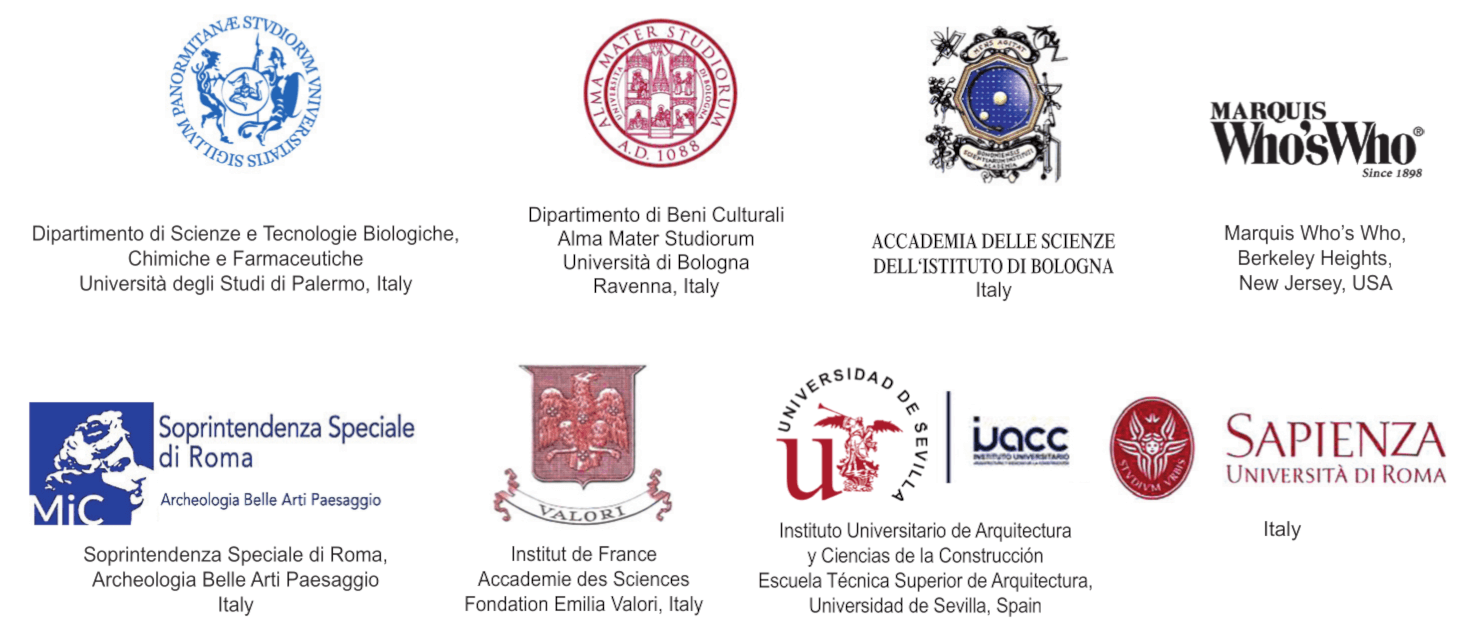Study of Materials and Techniques for the Conservation of Two Miniature Paintings
DOI:
https://doi.org/10.6092/issn.1973-9494/7943Keywords:
oil painting, deterioration, safflower oil, mounting, conservation, alla-primaAbstract
This research includes a study on the conservation of two miniature paintings produced by unknown artists and probably dated to the second half of the 18th century. These paintings are registered at the Museum of Helwan University, Faculty of Applied Arts, Giza, Egypt, No. (A) of 100/6.
This research also includes a historical and artistic study of the paintings. To study the materials and techniques used in their execution, several methods were used. XRD, XRD-EDAX was used for the examination and analysis of inorganic materials; in the case of organic materials, FTIR, UV was used to identify the pigment materials, glue, varnish, isolation layer or condition of the paper support. The oil medium in the paint layer was identified by the GLC method. Cross sections of both paintings were examined to find out about the technical knowledge used in constructing the painting / pictorial layers.
Finally, this research involves a study of how to separate two oil paintings executed on one paper support, and the most important procedures needed to carry out this step, as well as those necessary for reconstructing the painting layers. In addition, a new method is described to treat cracks.
Another new method was used to protect the paper support of these paintings from high relative humidity. This research also proposes a new tear mending method for paper objects instead of the traditional methods used in international paper and manuscript conservation laboratories.
References
Saladino, M. L., Ridolfi, S., Carocci, I, Martino, D. C., Lombardo, R., Spinella, A., Traina, G. and Caponetti, E. (2017). A multi-analytical non-invasive and micro-invasive approach to canvas oil paintings. General considerations from a specific case, Microchemical Journal 133, pp. 607–613.
Sims, E. E., Marshak, B. I, Grube, E. J. (2002). Peerless Images: Persian Painting and its Sources. Iranian Studies, 37(3), pp. 552-556.
Mohie, M. A. (2005). Technological and Technical Consideration in the conservation of a Banani’s painting, In: “Nile and Water resources in Egypt through Ages” / 5th Fayoum Conference, Faculty of Archaeology, Fayoum University, 2 - 4 April,Fayoum, pp. 104, 110.
Helmi, F. M. and Mohie, M. A. (1992). Non – Destructive study of an oil painting from 19th century Egypt. In: 3rd international conference on non – destructive Testing, Micro analytical Methods and Environment Evaluation for Study and Conservation of Works of Art, Instituto Centrale del Restauro, 4 – 8 October, Roma, p. 738.
Abdel Hamid, H. (1984). Scientific methods for the treatment and Conservation of manuscripts and wood and archaeological textiles. The Egyptian General Book Organization, Cairo, pp. 119-127, 302-303.
Smith, J. N. and Berry, L. G. (1967). Index to the Powder Diffraction File. American Society for Testing and Materials: Pennsylvania.
Mohie, M. A. (2005). A comparative study for the technology and techniques of oil painting for two Egyptian artists, and the influence of that on aspects of deterioration and treatment. In: “The Concept of conservation and restoration of objects: an applied study on Ikhnaton museum” / International Conference and Workshop in Restoration, Faculty of Fine Arts, Minia University, March, Minia, p. 134.
Adelantado, J. V. G., Castro, R. M., Carbo, M. T. D., Reig, F. B., Carbo, A. D., Catalan, M. J. C. and Cortina, L. O. (2001). Identification of Lipid binders in Painting by Gas Chromatography influence of the pigments. Journals of Chromatography A, 922, pp. 385-390.
Benham, A. M. (2000). The Minassion Collection of Persian, Mugal and Indian Miniature Paintings. Brown University Library, pp. 1-8.
Mills, J. and White, R. M. (1994). The Organic Chemistry of Museum Objects, Second Edition. Butterworth and Heinemann: U.K.,pp. 142-151.
Delamore, F. and Guinea, B. (2000). Color Making and Using Dyes and Pigments First Edition. Thomes and Hudson, p. 44.
Mills, J. and White, R. M. (1994). The Organic Chemistry of Museum Objects Second Edition. Butterworth and Heinemann: U.K., pp. 142-151.
Balazsy, A. T. and Eastop, D. (1998). Chemical Principals of Textile Conservation First Edition. Butterworth and Heinemann, pp. 76-96.
Mills, J. and White, R. M. (1994). The Organic Chemistry of Museum Objects Second Edition. Butterworth and Heinemann: U.K., pp. 142-151.
Robertson, S. M. (1973). Dyes From Plants. Van Norstrand Reinhold Company: New York, p. 84.
Mohie, M. A. (2004). A scientific study to Separate two Paintings on Paper Support, and reconstruction of Layers and their treatment and Conservation. In: studies in Arab world archaeology /7th Conference of Arab Archaeologists Association, 2 – 3 October, Cairo, p. 1098.
Burge, D. M., Reilly, J. M. and Nishimura, D. W. (2002). Effects of enclosure paper and paper board containing lignin on photographic image stability. Journal of American Institute for Conservation, 41, pp. 279- 290.
Vicente, J. P., Adelantado, G. J. V, Domenech, C. M. T., Mateo, C. R., Bosch, R. F. (2005). Identification of Lipid Binders in old oil paintings by separation of 4-bromomethyl-7-methoxycoumarin derivatives of fatty acids by liquid chromatography with fluorescence detection. Journal of Chromatography A, 1076, pp. 44-50.
Feller, R. L., Stolow, N. and Jones, E. H. (1985). On Picture Varnishes and their Solvents. National Gallery of Art: Washington.
Mohie, M. A. (2005). Scientific Study of Oil Painting Treatment from Cracks and Craquelure using Cauter. In: “The Concept of conservation and restoration of objects: an applied study on Ikhnaton museum” / International Conference and Workshop in Restoration, Faculty of Fine Arts, Minia University, March, Minia, Pp. 95-122.
Lienardy, A. (1994). Evaluation of seven mass deacidification treatment. Restaurator 15(1), pp. 1-25.
Jessell, B. (1977). Helmul Ruhemann’s Inpainting Techniques. Journal of American Institute for Conservation, 17(1), pp. 1-8.
Williams, S. (1995). CCI analytical Report: Retouching in easel painting suitability of the maimeri paints for inpainting and retouching of oil pictures on canvas, Wydawnictwo Uniwersytetu Mikolaja Kopernika, Poland, Torun, pp. 96-103.
Phibbis, H. (2004). To glaze or not to glaze an oil painting, Preservation practice. National Gallery of Art: Washington, pp. 104- 108.
Mohie, M. A. and Brania, A. A. (2008). Alternative Supports: an experimental and applied study on oil and wall paintings. In: “Giza through ages” /1st international conference, Faculty of Archaeology, Cairo university, 4 – 6 March, Cairo, pp. 65-73.
Downloads
Published
How to Cite
Issue
Section
License
Copyright (c) 2017 Moustafa Attia Mohie, Mahmoud Sayed Korany
Copyrights and publishing rights of all the texts on this journal belong to the respective authors without restrictions. Authors grant the journal right of first publication.This journal is licensed under a Creative Commons Attribution 3.0 Unported License. (full legal code)See also our Open Access Policy.






